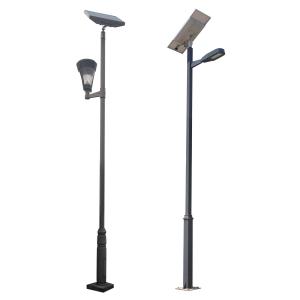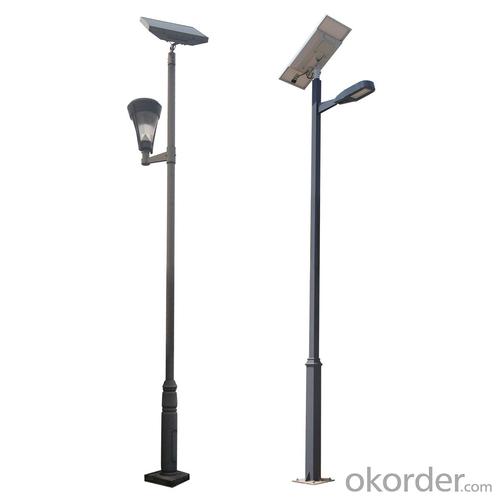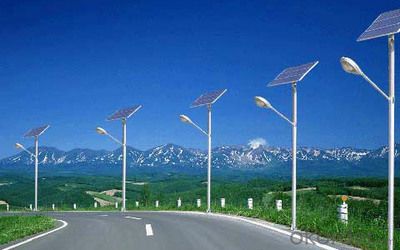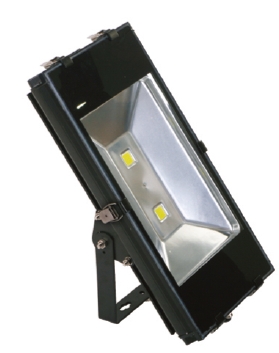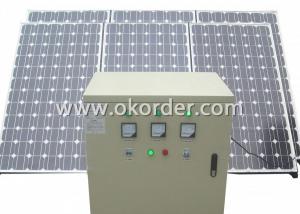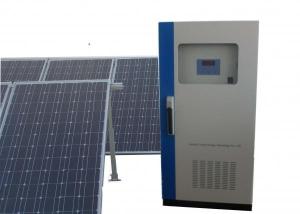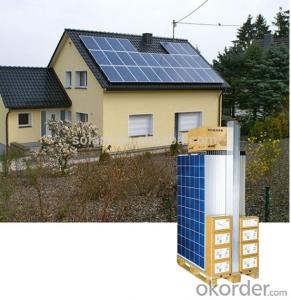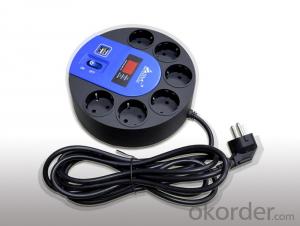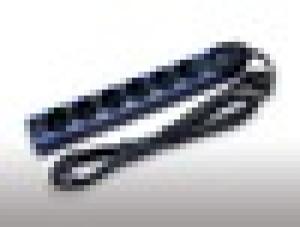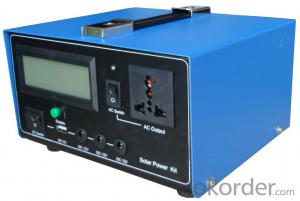Solar Energy Systems Silloth - High Efficiency & New Energy Solar Products
- Loading Port:
- Shanghai
- Payment Terms:
- TT or LC
- Min Order Qty:
- 10 pc
- Supply Capability:
- 5000 pc/month
OKorder Service Pledge
OKorder Financial Service
You Might Also Like
1, Product desciption
Inverter circuits designed to produce a variable output voltage range are often used within motor speed controllers.
The DC power for the inverter section can be derived from a normal AC wall outlet or some other source. Control and feedback circuitry is used to adjust the final output of the inverter section which will ultimately determine the speed of the motor operating under its mechanical load.
Motor speed control needs are numerous and include things like: industrial motor driven equipment, electric vehicles, rail transport systems, and power tools. (See related: variable-frequency drive ) Switching states are developed for positive, negative and zero voltages as per the patterns given in the switching Table.
The generated gate pulses are given to each switch in accordance with the developed pattern and thus the output is obtained.
Solar power is energy from the sun. "Solar" is the Latin word for "sun" and
And Powerful source of energy. Without it, there will be no life.
Solar energy is considered as a serious source of energy for many years
of the vast amounts of energy that is made freely available, if harnessed by modern technology.
A magnifying glass can be used to heat up a small amount of water.
The short piece of copper tube is sealed at one end and filled with water.
And magnifying glass is then used to warm up the pipe.
Using more than one magnifying glass will increase the temperature more rapidly.
2, Features of the product
Inverters convert low frequency main AC power to higher frequency for use in induction heating.
To do this, AC power is first rectified to provide DC power. The inverter then changes the DC power to high frequency AC power. Due to the reduction in the number of DC Sources employed, the structure becomes more reliable and the output voltage has higher resolution due to an increase in the number of steps so that the reference sinusoidal voltage can be better achieved.
This configuration has recently become very popular in AC power supply and adjustable speed drive applications. This new inverter can avoid extra clamping diodes or voltage balancing capacitors. There are three kinds of level shifted modulation techniques, namely: 1,High and stable conversion efficienly based on over 4 years professional experience
2 ,High reliability with guaranteed +/-10% output power tolerance
3,Proven materials,tempered front glass,and a sturdy anodized aluminum frame allow modules to operate reliably in multiple mountily configurations
4,Combination of high efficicncy and attractive appearance
The first thing to figure out is the length of road in need of street lights.
This can be a small entrance road only a couple hundred of feet long to miles of streets through an area. Does the area currently have any type of lighting available.
What is the reason for needing street lights in this area
Is the electrical grid already nearby or would you need to call in the power company to bring in electrical lines.
If the electric needs to be brought to the area, how much is this going to cost? Depending on how far the grid electric is from the location of the needed lighting, this can be quite expensive.
How much lighting is needed on the street? Do the lights need to be dark sky compliant.
Do the street lights need to run from dusk to dawn or for only a specified number of hours at night.
Are the street lights able to dim in the middle of the night and still provide enough lighting.
These questions need to be answered before you can decide on how many lights you will need to complete the project.
3, Detailed Specification
| ||||||||||||||||||||||||||||||||||||||||||||||||
4, Product Image

- Q: Can solar energy systems be used in commercial agriculture?
- Yes, solar energy systems can be used in commercial agriculture. They can provide a sustainable and cost-effective solution for powering various agricultural operations such as irrigation systems, greenhouse heating, and livestock facilities. Solar panels can be installed on rooftops or as ground-mounted systems in farms to harness the sun's energy and generate electricity for on-site use. This helps reduce reliance on traditional energy sources, lowers operational costs, and promotes environmentally friendly practices in commercial agriculture.
- Q: How does a solar panel convert sunlight into electricity?
- A solar panel converts sunlight into electricity through the photovoltaic effect. The panel contains silicon-based solar cells that absorb photons from sunlight. These photons transfer their energy to electrons in the silicon atoms, causing them to become excited and break free. The electric field within the solar cell then directs these electrons to flow in a specific direction, creating a current. This current is then harnessed and used as electricity.
- Q: Can solar energy systems be used in powering outdoor signage or billboards?
- Yes, solar energy systems can be used to power outdoor signage or billboards. Solar panels can be installed on the roof or nearby structures to harness sunlight and convert it into electricity. This electricity can then be used to power the lights or digital displays of the signage or billboards, making them completely independent of the traditional power grid. Solar energy systems are particularly suitable for outdoor signage as they are often located in areas with abundant sunlight. Additionally, using solar energy helps reduce the carbon footprint associated with traditional electricity generation, making it an environmentally friendly choice.
- Q: Can solar energy systems be used for powering restaurants?
- Certainly, solar energy systems can be employed to power restaurants effectively. Photovoltaic (PV) systems, also referred to as solar energy systems, convert sunlight into electricity through the utilization of solar panels. These solar panels can be positioned on the rooftop or any other suitable location to capture sunlight. Restaurants generally have substantial energy requirements due to the necessity of lighting, heating, cooling, and a variety of kitchen appliances. By making use of solar energy systems, restaurants can significantly decrease their dependence on conventional energy sources and lower their electricity expenses. The electricity generated by solar panels can be utilized to power all aspects of a restaurant's operations, encompassing lighting, refrigeration, cooking equipment, and HVAC systems. Any surplus electricity generated during peak sunlight hours can be stored in batteries for use during periods of cloudy weather or at night, ensuring a continuous power supply. Furthermore, solar energy is an environmentally friendly and sustainable power source, which implies that it has a minimal impact on the environment. By adopting solar energy systems, restaurants can demonstrate their commitment to sustainability and reduce their carbon footprint. This can also serve as a valuable marketing tool, attracting environmentally conscious customers who appreciate businesses that prioritize renewable energy. In conclusion, solar energy systems provide a feasible and effective solution for powering restaurants. They offer a dependable and sustainable source of electricity, reduce operational expenses, and showcase a commitment to environmental consciousness.
- Q: Can solar energy systems be used in areas with high levels of snowfall?
- Yes, solar energy systems can be used in areas with high levels of snowfall. While snow can reduce the amount of sunlight reaching the solar panels, it does not render them completely ineffective. Modern solar panels are designed to be efficient in various weather conditions, including snow. Additionally, the angle and tilt of the panels can be adjusted to shed snow and maximize sunlight absorption. In snowy regions, it is common to mount solar panels at steeper angles to help snow slide off. Furthermore, advancements in solar technology, such as the use of anti-reflective coatings and self-cleaning mechanisms, help prevent snow buildup and maintain optimal performance. It's worth noting that while snow can temporarily reduce energy generation, solar energy systems can still produce electricity even in cloudy conditions. Overall, with proper planning and maintenance, solar energy systems can be effectively utilized in areas with high levels of snowfall.
- Q: What happens to excess energy generated by a solar energy system?
- Excess energy generated by a solar energy system can be stored or sold back to the grid. When a solar energy system produces more electricity than is being consumed, the excess energy can be stored in batteries for later use. This stored energy can be utilized during times when the solar panels are not generating enough electricity, such as during nighttime or cloudy days. Alternatively, if the solar energy system is connected to the electrical grid, the excess energy can be fed back into the grid. This process is known as net metering. In net metering arrangements, the excess energy is fed into the grid, and the owner of the solar system receives credit for the electricity they provide. This credit can then be used to offset the electricity consumed from the grid when the solar panels are not generating enough power. By either storing excess energy or selling it back to the grid, solar energy systems ensure that no energy goes to waste. This not only maximizes the efficiency and utilization of solar power but also allows solar energy system owners to benefit financially from their excess generation.
- Q: Can a solar energy system be installed on a museum or cultural institution?
- Yes, a solar energy system can be installed on a museum or cultural institution. Solar panels can be mounted on the roof or in an open space surrounding the building to harness sunlight and convert it into electricity. This can help the institution reduce its reliance on conventional energy sources, lower its carbon footprint, and potentially save on electricity costs in the long run. Additionally, the installation of solar panels can also serve as an educational display, highlighting the institution's commitment to sustainability and renewable energy.
- Q: Can solar energy systems be used for powering electric vehicle showrooms?
- Yes, solar energy systems can certainly be used to power electric vehicle showrooms. Solar panels can be installed on the rooftops or surrounding areas of the showroom to generate electricity from sunlight. This renewable energy source can then be used to power the lighting, charging stations, and other electrical systems within the showroom. By utilizing solar energy, electric vehicle showrooms can reduce their carbon footprint, save on electricity costs, and showcase a sustainable approach to the promotion of electric vehicles.
- Q: How do solar energy systems impact energy conservation efforts?
- Solar energy systems have a significant impact on energy conservation efforts, as they harness the power of the sun to generate electricity without depleting natural resources or emitting harmful greenhouse gases. By utilizing solar power, we reduce our reliance on fossil fuels, which helps to minimize air pollution and combat climate change. Solar energy systems also encourage energy conservation by promoting efficiency and raising awareness about sustainable practices.
- Q: Can solar energy systems be used in areas with limited access to solar monitoring systems?
- Yes, solar energy systems can still be used in areas with limited access to solar monitoring systems. While solar monitoring systems can provide valuable data and insights for optimizing the performance of solar energy systems, they are not essential for the basic functionality of the systems. Solar panels can still generate electricity from sunlight even without monitoring systems. However, without access to solar monitoring systems, it may be more challenging to track and assess the performance, diagnose issues, and monitor the overall efficiency of the solar energy systems.
Send your message to us
Solar Energy Systems Silloth - High Efficiency & New Energy Solar Products
- Loading Port:
- Shanghai
- Payment Terms:
- TT or LC
- Min Order Qty:
- 10 pc
- Supply Capability:
- 5000 pc/month
OKorder Service Pledge
OKorder Financial Service
Similar products
Hot products
Hot Searches
Related keywords
